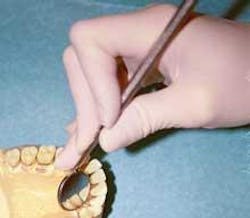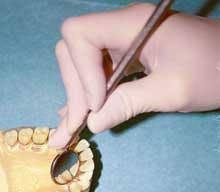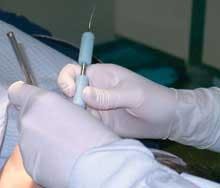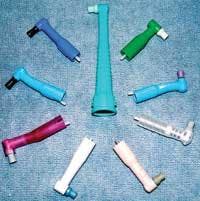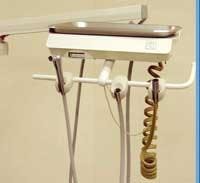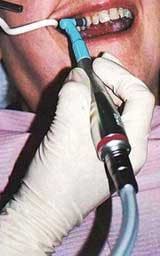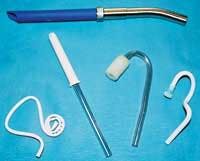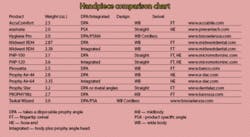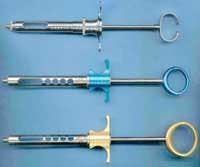Instrument design: Understanding the Fine Details
There’s a method behind the daily repetitiveness of treatment, and the goal is to keep you at your physical peak.
Ergonomics is a big buzzword today. Many industries are concerned about workplace-related musculoskeletal disorders. During the past two decades, more and more dentists, hygienists, and assistants have developed short-term as well as permanent disabilities. Often, these disabilities are a direct result of repetitive stress injuries directly related to tasks performed in the dental office.
Typically, a discussion about instruments is limited to items such as periodontal hand scalers and curettes, or restorative and operative hand instruments. Any device that we use in our hands clinically has the potential to create stress upon our bodies. Two major factors contribute to injuries related to instruments. The first factor is the design of the actual instrument, and the other one is how we use the device.
For example, everyone involved in clinical practice uses a hand-held mouth mirror. Many skinny metal handles are in use every day, and some of the older designs in handles are also very heavy. A mouth mirror - and how we use it - can provide a significant source of irritation to the muscles, nerves, joints, tendons, and ligaments in a clinician’s hands, forearms, shoulders, and even the upper back and neck. Often, these traumas show up on a clinician’s nondominant side.
When thin is not trendy
To help reduce the ergonomic stress hand instruments put on the body, instrument manufacturers develop handle designs that decrease these stresses. Larger diameter instruments limit pinch-grip, which results in a more relaxed hand posture. This is one time when thin is not in!
Years ago, instrument handles were either octagonal with a tiny crosshatched texture on the handle surface, or they were round and smooth. Companies now focus on creating new types of texture patterns on the handles. While the majority of instrument handles are still a long, round tube, a few companies have created handles that have surfaces that are slightly curved at strategic points, or the overall surface is heavily dimpled, creating a comfortably natural finger rest. Regardless of the design, a textured surface improves traction, especially in wet conditions, which are prevalent in most dental procedures.
Along with larger diameter handles and textured surfaces, most instrument handles are no longer solid metal. Ergonomists know that excess weight can create unnecessary stress and fatigue. The choices now range from hollow metal, resin/metal combinations, silicone/metal designs, to all-resin models. Both hollow metal and metal/resin designs reduce the overall instrument weight.
Some instrument handles are padded. These designs feature padded medical-grade silicone grips fitted over a metal core. All-resin instruments, which are the lightest, became available about a decade ago. While all-resin instruments can be a blessing to healthy clinicians, those who have experienced a reduction in tactile sensitivity because of nerve parasthesia in the fingers may increase their pinch-grip in order to gain a sense of control over the instrument.
What can you do if your instrument is skinny but still serviceable? Add a medical-grade silicone grip to increase the handle diameter. Several entrepreneurial hygienists, who can no longer practice because of workplace-related injuries, have invented products that fit the bill perfectly. The Acushy Air, Chub EZE, and ErgoGrasp grips can enlarge any slim handle. These products are autoclavable, improve handle texture, create a comfortable, cushiony grip, and come in a variety of colors.
The original disposable Acushy is a cigar-shaped grip that fits beautifully over a mirror handle, giving the clinician a relaxed, cushioned grip, which is critically important when using a mirror as a retraction tool. Many clinicians suffer from hand and thumb pain because they use a “death grip” on the handle during retraction. Some use surgical retraction tools rather than mouth mirrors. These devices have a larger gripping surface, which can reduce overall hand fatigue.
Designs keep a sharper edge longer
Two companies now offer instruments that require less sharpening over time in order to maintain a proper edge. Hu-Friedy recently introduced the EverEdge line of scalers and curettes. A special stainless steel alloy allows the instruments to stay sharp 50 percent longer than their standard instruments. American Eagle Instruments’ XP Gracey curettes are made from a specially coated, hardened stainless steel, which keeps the blade sharp longer. Testing indicates that the XP blade handles 10 times the number of strokes with only one-tenth the wear to the instrument blade.
Several companies offer instruments that have replaceable tips. This allows clinicians to develop their own customized instruments. Another advantage to this system is the ability to replace a broken tip and put the instrument back into service immediately.
Some dental practices attempt to operate with a bare minimum number of instruments or set-ups for routine procedures. How much effort and valuable production time does an office staff waste as they scurry around looking for a set of autoclaved instruments? Typically, offices that have this practice philosophy go into a tizzy when an extra patient is squeezed into the schedule, instruments are not autoclaved in time, or - heaven forbid - an instrument drops onto the floor. Having an ample number of instruments on hand allows clinicians to practice more efficiently, in addition to reducing unnecessary stress in the workplace.
It is important for clinicians to select the instruments that work best in their hands. Wise employers respect a clinician’s personal preference for the type and number of instruments that one needs for each procedure.
For example, the length of the instrument handle can vary between manufacturers. Clinicians that prefer an instrument with a longer handle will not feel comfortable using one that is short. In addition, not all clinicians have the same hand size. This can have a significant impact on instrument selection.
The advantages of ultrasonic
While hand instruments have been a mainstay for many clinicians, especially those trained 20 or 30 years ago, ultrasonic dental scalers are now appreciated in ways that we never expected. First, the portion of a magnetostrictive insert that one grips has a diameter similar to the large diameter of many contemporary hand instruments. Both all-metal and silicone-padded grips have textured surfaces, allowing clinicians to use a lighter grip, which improves tactile sensitivity. The shape of most piezoelectric handpieces is similar to the contemporary polishing handpieces and features a textured surface.
Thin, ultra-thin, as well as right and left ultrasonic tip configurations give today’s clinicians more choices than ever for effective deposit removal. Ultrasonic scalers are most effective when clinicians use a feather-light touch on the tooth surface. A light touch also improves tactile sensitivity and creates less musculoskeletal stress.
The handpiece cords on many newer ultrasonic scalers are lighter weight and have less cord torque. In addition, swivel technology creates even less stress on the user’s body. The Hu-Friedy Satin Swivel magnetostrictive insert features a 360-degree fingertip swivel as well as an enlarged, silicone-padded grip. Dentsply’s SteriMate handpiece has a 320-degree hose-end swivel mechanism.
Many clinicians use handpieces specifically designed for polishing. Hand fatigue and wrist positioning are serious concerns. Handpiece weight can vary dramatically. Thirty years ago, polishers weighed as much as 9.5 ounces, with much of the weight concentrated at the motor end, causing strain on the user’s wrist and forearm. Unfortunately, many of these devices are still in use. Today’s polishing handpieces are well balanced and range from 2 to 3.6 ounces in weight.
Most contemporary handpieces feature swivel mechanisms that function with either a fingertip-activated swivel or a hose-end rotating coupler. A number of companies also make handpieces that are extra wide at one end, resulting in a more relaxed hand position. The width of the new KaVo PROPHYwiz handpiece falls between the straight and the wide-bodied polishers, making it an important choice for clinicians that prefer a polisher that is less bulky at the hose end.
It is important to address all parts of an ergonomic problem. Old, heavy coiled cords that create significant torque significantly compromise the wonderful benefits of today’s lightweight polishing devices. Newer handpieces, hooked up to lightweight straight air hoses, will really shine.
The Brasseler USA-NSK Hygiene Pro and Taskal Wizard handpieces are the only cordless, multi-speed, rechargeable polishing devices. This unique design eliminates the weight and torque of the air hoses, as well as being completely portable. The Hygiene Pro is designed specifically for polishing, while the Taskal handpiece can be used for endodontic procedures as well. Both can either accept a disposable prophy angle or use a specially designed autoclavable all-metal contra-angled head.
Several newer handpieces have the prophy angle head integrated into the handpiece body. The Micro Motors PHP-120 and one model of the Midwest RDH handpiece have removable right angle heads. The new A-Dec Prophy Air 64 features a fully integrated contra-angled handpiece.
All shapes and sizes of prophy cups
Years ago, prophy cups were quite straightforward. Today, prophy cups come in all different sizes, shapes, colors, and configurations. The first prophy cups were fabricated from natural rubber latex. Both soft and firm cups have been available for years. Originally, prophy cups were all one length, but short-cup designs now account for 50 percent of all sales. Cups come with either a screw-in or a snap-on connection. A latch-type handpiece requires a mandrel-mounted cup. The surface on the inside of the cup can be either plain, ribbed, webbed, or have a diagonal fluted surface with webs.
Screw-in cups maintain a more concentric shape during polishing and, as a result, tend to wobble less than snap-on cups. To reduce slippage, it is important that snap-on cups and their angles be dry and oil-free before placing the cup on the knob. Most disposable angles have snap-on cups, but all Young disposable angles use screw cups.
Small, short cups are much easier to use when polishing children’s teeth or patients with limited openings. The task is easier for you and more comfortable for your patient.
Prophy angles with a right angle silhouette have been popular for years. Ten years ago, Young Dental created the Contra Prophy angle, which has a small bend in the body. This design feature allows clinicians to maintain an ergonomically correct neutral wrist position, even when polishing posterior teeth or lingual surfaces. Smart Practice offers a disposable angle known as the Swangle 360. The fully rotating head has seven different lock-down positions. This design is particularly beneficial when used in combination with a nonswiveling handpiece.
Preventech’s esa prophy angle is a hybrid right angle design. It has an extended body that replaces the slow speed straight attachment. This decreases the overall weight of the handpiece. The esamate is a lightweight, straight swiveling handpiece, designed exclusively for the esa prophy angle. This creates a balanced polishing device.
Disposable angles weigh less than metal angles and metal angles require time to maintain, so ergonomic issues and time considerations may negate the perceived savings of using an autoclavable metal angle.
Suctioning, clear mirrors, and even the lab
Suction devices can be another source of either comfort or annoyance. There are saliva ejectors that rest comfortably, hands-free in the vestibule. Standard saliva ejectors can be bent so they stay in the vestibule all by themselves.
An additional variation on this theme is the combination mouth mirror/suction device. The mirror handle attaches directly to a high- or low-speed suction device. Tiny openings around the mirror’s edge act as multiple saliva ejectors. The Isolite is a combination suction, illumination, and isolation device. Clinicians can adjust both the intensity of the fiber optic light and the rate of fluid evacuation.
Take an inventory of your mirrors. If the surfaces are scratched or dull, replace them with new ones. Poor quality, worn-out mirrors make it difficult to provide high quality dental care. Keep a package of autoclaved mirror heads right in the treatment room, and replace worn-out heads in a timely fashion.
Smaller diameter mirror heads are invaluable when working with small children, patients with limited openings, or those that have a sensitive gag reflex. Double-sided mirrors improve the amount of light as well as clinical efficiency.
There are also illuminated dental mirrors. Welch Alyn has just introduced the cordless DenLite mirror. This rechargeable LED model can also double as an illuminated retraction tool. The Mirroscope by Miras takes technology to an even higher level. This device is an illuminated intraoral mirror that sends a magnified image directly to a video monitor, much like an intraoral camera. The device is operated with either an infrared remote control or a standard foot pedal.
Commercially available products help keeps the mirror fog-free, but mouthwash will work as well. It changes the surface tension so water flows off in a sheeting action rather than forming droplets on the face of the mirror. Either dip the mirror into a dappen dish full of the rinse or periodically wipe a piece of mouthwash-dampened gauze over the surface of the mirror. Premoistened gauze squares can either be stored in a container or prepared at the beginning of each appointment. A light application of mouthwash from a small spray applied directly to the mirror surface also creates a clear mirror image.
Ergonomic design has even crept into the laboratory arena. Palmero Health Company makes mixing spatulas that have a hand-conforming grip that makes it much more comfortable to mix products like alginate impression material. Both right- and left-handed spatulas are available. Mixing bowls that are smaller and more flexible make mixing and clean-up a snap.
Dental professionals need instruments that work well in our hands, allowing us to have predictable clinical outcomes without undue stress on our bodies. Manufacturers are are developing wonderful products that will help us perform better clinically, and help us reduce the risk of a workplace-related repetitive stress disorder.
If your body is sending a wake-up call, why not try some new products that can help make your clinical day less fatiguing?
Anne Nugent Guignon, RDH, MPH, is an international speaker, has published numerous articles, and authored several textbook chapters. Her popular programs include ergonomics, patient comfort, burnout, and advanced diagnostics and therapeutics. Recipient of the 2004 Mentor of the Year Award, Anne is an ADHA member and has practiced clinical dental hygiene in Houston, Texas, since 1971. You can reach her at [email protected] or (713) 974-4540 and her Web site is www.ergosonics.com.
References/additional reading
Andrews N, Vigoren G. Ergonomics: muscle fatigue, posture, magnification and illumination. Compend Contin Educ Dent. 2002; 23(3) :261-266,268,270.
Andrews N. Sharpeners can give you the edge. COH. 2004; 4(8)8-10,12,14.
Bleeker ML. A medical-ergonomic program for prevention of upper extremity and back disorders in the practice of dentistry. In DC Murphy (Ed.), Ergonomics and the dental care worker.1998. pp.341-354. Washington, D.C.: Amer Pub Health Assn.
Carayon P, Smith MJ, Haims MC. Work organization, job stress, and work related musculoskeletal disorders. Hum Factors 1999: 41(4):644-63.
Finsen L, Christensen H, Bakke M. Musculoskeletal disorders among dentists and variation in dental work. Appl ergon 1998; 29(2):119-25.
Fredekind R, Cuny E. Instruments used in dentistry. In DC Murphy (Ed.), Ergonomics and the dental care worker.1998. pp.169-289. Washington, D.C.: Amer Pub Health Assn.
Gerwatowski LJ, McFall DB, Stach DJ. Carpal tunnel syndrome-Risk factors and preventive strategies for the dental hygienist. J Dent Hyg1992;66(2):89-94.
Gomolka K. Dental ergonomics: Instrumental ideas for reducing hand and eye strain. Dent Prod Rep 2000;(3):104-113.
Guignon AN. Ergonomics. In MD Cooper, L Wiechmann (Eds.) Dimensions of preclinical dental hygiene: A practical approach. New Jersey: Prentice Hall, 2004: 173-197.
Guignon AN. Handpiece. Dent Econ 2001; 91(10):96-8,100.
Horstman SW, Horstman BC, Horstman V. Ergonomic risk factors associated with the practice of dental hygiene: A preliminary study. Am Soc Safety Eng 1997;April:49-53.
Liskiewicz ST, Kerschbaum WE. Cumulative trauma disorders: an ergonomic approach for prevention. J Dent Hyg 1997;71(4):162-7.
Liss G, Jesin E. Musculoskeletal problems among dental hygienists: A Canadian study. In DC Murphy (Ed.), Ergonomics and the dental care worker.1998. pp.143-168. Washington, D.C.: Amer Pub Health Assn.
Mani L, Gerr F. Work-related upper extremity musculoskeletal disorders. Prim Care 2000;27(4):845-64.
Marks R. Proceed with caution. RDH 2003;23(10);60,62,64,94.
Michalak-Turcotte C, Atwood-Sanders M. Ergonomic strategies for the dental hygienist - Part II. J Prac Hyg 2000; 9(3)35-38.
Michalak-Turcotte C. Controlling dental hygiene work-related musculoskeletal disorders: The ergonomic process. J Dent Hyg 2000; 74(1):41-48.
Milerad E, Ericson MO. Effects of precision and force demands, grip diameter, and arm support during manual work: and electromyographic study. Ergonomics 1994;37(2)255-64.
Nunn PJ, Hart C, Gaulden, F. ‘Perfect’ instrumentation can be hazardous to your health!-or-ergonomic applications for the prevention of carpal tunnel syndrome. Access 1995;9(1):37-43.
Nunn PJ. Getting a handle on ergonomic periodontal instrument design. Access 1997;11(3):16-19.
Oberg T, Karsznia A, Sandsjo L, Kadefors R. Work load, fatigue and pause patterns in clinical dental hygiene. J Dent Hyg 1995;69(5);223-9.
Poindexter SM. All the right moves: ergonomics and the dental hygienist at work. Access 1995;9(1):19-28, 33.
Scott W. Power and hand scaling: Why choose one? COH 2005;5(3):22-23.
Stitik TP, et al. An analysis of cumulative trauma disorders in dental hygienists. J Prac Hyg 2000;9(2)19-25.
Tatro DE. Ergonomics for the dental hygienist. J Prac Hyg 1997;6(1):35-39.
Today’s hand instruments are designed to accommodate different hand sizes. Ergonomic hand instruments are fabricated from new lightweight materials and feature larger diameter handles.
How automatic sharpeners came to the rescueHand instruments such as scalers and curettes do not last forever. Dental hygiene instruments require regular sharpening, which removes some of the metal. Even instrument sharpening machines make the face of the instrument smaller and smaller. Sharp instruments allow clinicians to perform exacting procedures with much less force, resulting in reduced hand and forearm fatigue. Clinicians using sharp instruments are more efficient and patients are more comfortable when instruments are sharp.
Each time an instrument is sharpened, the blade becomes smaller. Hand sharpening is not only tedious and time consuming, but many clinicians have difficulty maintaining a precise edge on a scaler or curette. This is particularly common if more than one clinician sharpens the same instrument. Poor sharpening techniques damage countless numbers of instruments.
Dental manufacturers now offer some very precise sharpening systems, which can virtually eliminate operator errors as well as greatly extend the useful life of a scaler or curette. Automatic sharpeners remove much less metal each time an instrument is sharpened, provided one uses a specific device as intended.
An automated sharpening device is not a miracle worker. It is nearly impossible to restore a worn-out instrument or one damaged by poor sharpening techniques with an automated device. Automated sharpeners that are used properly will keep instruments sharper from the time they are put into clinical service. Instruments that stay sharp and last longer can offset the cost of an automated sharpening device.
A smoother plunge with syringes
Another innovative instrument design has just appeared on the horizon. For years, clinicians with small hands or short fingers have struggled to give injections with standard size aspirating syringes. Standard syringes were too long, and the plunger ring was too big for comfort. In a desperate attempt to modify this design discrepancy, some users pad the inside of the plunger ring with cotton rolls or gauze. Septodont and Hu-Friedy now have syringes designed for the petite hand.
The overall weight of any instrument is determined by the size as well as the materials used to fabricate a device. A standard size stainless steel syringe weighs approximately 3 ounces. The new, all stainless steel Hu-Friedy Mini Aspirating syringe is about 2.25 ounces. Septodont uses a special lightweight metal alloy to fabricate their syringes. The standard syringe weighs just over 2 ounces and the new Septodont Petite is around 1.75 ounces.
Both the standard and petite Septodont aspirating syringes feature a special oval-shaped plunger ring that has softly sloping edges that are more comfortable than the squared-off edge. This unique design more closely approximates the natural anatomical shape of the thumb, in contrast to the more traditional round-plunger ring.
Product informationMost products mentioned in this article are available through dental product dealers. The following companies sell direct.
• Isolite, (800) 560-6066, www.isolitesystems.com
• Miras, (888) 399-1473, www.miras-imaging.com
• Acushy Product Company, (800) 292-9140, www.acushy.com
• Chub-Eze Instrument Grips, (800) 665-6764, www.handtech2000.com
• NSK - Brasseler USA, (800) 841-4522, www.brasselerusa.com
